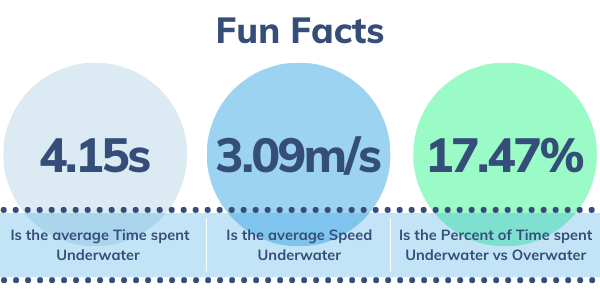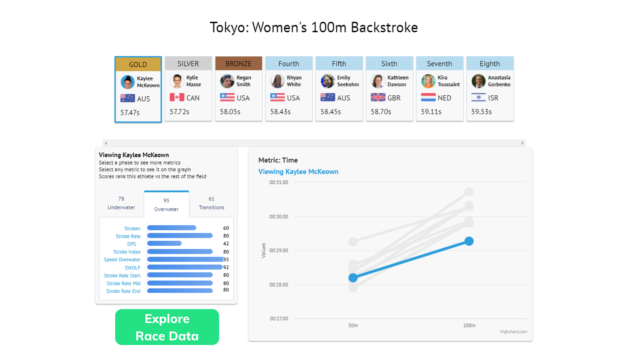We asked our swimming data partner TritonWear to help us with a deeper insight into performances and what makes elite swimmers fast and where they can improve. This is their TritonWear analysis.
Caeleb Dressel did it again, and this time, he won the gold and broke his own world record. The unstoppable American swimmer finished the race at an incredible 49.45, 0.05s faster than his 2019 World Championships WR time.
By Dressel standards, he was conservative on the first 50, staying behind the world record line and splitting 0.17s slower (23.0s) than his previous world record (22.83s). In true Dressel fashion, he hammered his way through to the finish line and left everything in the pool.
Ready to be blown out of the water? Check out this race’s legendary data.
For this analysis, we’re using the same TritonWear data 30+ national federations trust when training elite athletes, bringing you all the insights into faster swimming.
So let’s dive right in and nerd out on all things data. Dressel is known to get on the blocks, ready to take off and lead the pack. He does that seamlessly by pairing an explosive start at 0.6 Dive Block Time (reaction) along with a high Dive Hang Time (staying longer in the air) of 0.4s and an incredible Speed Underwater of 4.05m/s (his speed underwater after the start).
What’s most impressive is Dressel’s ability to hold a relatively steady Stroke Rate throughout. Dressel, in a similar pattern to his 100 Free, started the race with a Stroke Rate Start of 58.37 cyc/min, dropping it slightly in the middle with a Stroke Rate Mid of 56.02 cyc/min but ramping it up slightly towards the end of the first 50 with a Stroke Rate End of 56.91 cyc/min. His timing on the wall for the turn was not perfect, and that slight glide resulted in Dressel recording the slowest *Transition Time of 2.09s, 0.41s slower than the overall average of 1.68s (for all finalists).
*Transition Time is the glide time after the last hand entry + Turn time + Pushoff time (when feet leave the wall).
With his eye on the gold, he was determined to leave everything he had in the pool and made up for that glide with a fast turn and a sizzling 2.65m/s Speed Underwater still ahead of Milak’s 2.59m/s and Ponti’s 2.56m/s after the turn.
The real showdown began on the second part of the race, with Dressel charging towards the wall and Milak closing in. So how does Dressel keep his competition at bay?
While Dressel does not have the highest Stroke Rate (SR) out of the three world-class swimmers, he holds his SR steady and increases it as he approaches the finish line. On the contrary, Ponti’s SR is the highest, but unlike Dressel he drops it towards the end. Different still is Milak, with the lowest SR out of the three, and like Ponti, he decreases it as he approaches the wall.
Here’s a play by play on their Stroke Rate Start- Mid- End for their second lap:
Dressel: 55.66-57.2-56.91 (cyc/min)
Milak: 52.01-51.96-50.56 (cyc/min)
Ponti: 60.91- 59.65- 57.83 (cyc/min)
Although Stroke Rate (SR) is more favoured than Distance Per Stroke (DPS) in events like the 100 FL, it’s essential to look at the relationship between the two metrics to understand their tradeoffs. For instance, while Milak didn’t maintain Dressel’s stroke rate, his longer DPS coupled with his Stroke Rate clocked him to a 26.03s split on that 2nd lap, 0.42s faster than Dressel’s 26.67s.
Here is their SR (avg) to DPS (avg) relationship:
Dressel: SR 56.33 cyc/min – DPS 2.08 m/cyc
Milak: SR 51.45 cyc/min – DPS 2.23 m/cyc
Ponti: SR 58.70 cyc/min- DPS 1.91 m/cyc
Draw Your own Conclusions
Head over to TritonWear’s epic Race Analysis page
to explore every detail of each swimmer’s race data.
We understand that not all coaches and swimmers are data-heads. Analyzing data requires a lot of time and effort that, frankly, most don’t have. At TritonWear, we strive to make data quick, easy, and fun to use so you can focus on swimming and leave the number-crunching to us.
With a glance at the Triton Score, you’ll know instantly how well you trained and even get personalized feedback highlighting exactly where you’re excelling and what you need to improve on to swim faster.
Athletes: Get started with as little as $20/month and receive a free unit (included with your membership).
Coaches: Create highly personalized winning strategies for individual swimmers and the team as a whole with data-driven insights. 30+ national federations trust us to help them train these elite athletes; you can too. * Volume prices apply.
About TritonWear
TritonWear is a sleek wearable device and app that helps you train well consistently, so you can swim faster. It captures and relays 30+ data points in real-time to any mobile device on deck. Triton Score analyzes your data and provides you with actionable insights highlighting exactly where you’re excelling and what you need to improve on to swim faster.





Slower turn means bigger breath at the wall.
My takeaway is that Milak swimming is faster than Dressel. His strokes are stronger and longer. He only needs to improve his start and turn and Dressel is over…
Yea….that simple. I’m sure the rest of the world will get right on that seeing all the progress they’ve made in the last 5 years 😂
And Milak needs to keep his head down for the last four strokes so he can maintain or increase his stroke rate like Dressel does.
My takeaway is that he lost .41 on the field in the turn and a bit more at the finish. A perfect race for him would be close to 48.99
Didn’t breathe last 5 strokes. If he only put his head down for 3 strokes, he might have seen the wall and timed his finish better.
Don’t fix what isn’t broken. That finish literally broke the last Olympic champions career.
Didn’t breathe last 15 meters. That’s his super power. They will catch him but then he puts his head down and holds them at bay. Hence the increased stroke rate. Same in the 100 Free.
The biggest takeaway I’m getting:
He’s very fast
TL:DR version – long on the turn and even longer at the finish. He had a 49.1x in him! The so-called “project 48” may not be so far fetched!
Now that he has delivered the olympic gold-medal performances the monkey is off his back and he can go for the 48 in Fukuoka (..and the sub 46.9 100Fr). Looking forward to Worlds already!